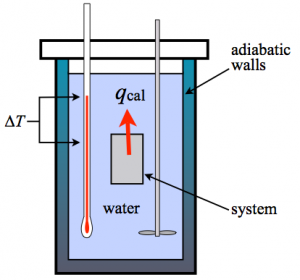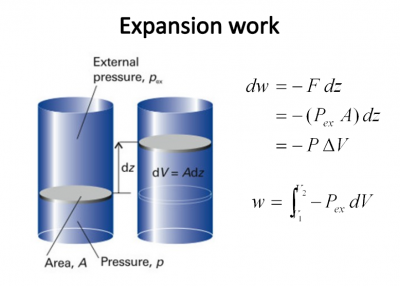PChem312 f20 w3
Revision as of 14:53, 31 August 2020 by Bes (talk | contribs) (→Sec 2.1: Internal Energy and !st Law of Thermodynamics)
Monday, Aug 31, 2020
Continue reading chapter 2
Sec 2.1: Internal Energy and !st Law of Thermodynamics (review)
U <-- internal energy (1st thermodynamic state function)
- Uf - Ui = ΔU, the change in the internal energy
- we cannot measure Uf or Ui, only ΔU.
First Law of Thermodynamics: the change in the system's internal energy is equal to, but opposite in sign, to the change in the surround's internal energy.
- ΔUsys = - ΔUsurr
How does one measure ΔU?
- - changes in the system variables (ΔP, ΔV, ΔT, Δn) are an indication of ΔU; changes in system variables result in either heat (q) transfer or work (w) being done on or by the system; calculation of q or w leads directly to ΔU.
- ΔP, ΔV, ΔT, Δn --> q (heat), w (work) --> ΔU
- Heat and work are both defined as a transfer of energy between the system and surroundings.
The first Law of thermodynamics can also be stated as:
- ΔU = q + w
Sec 2.2: Heat (q)
- Heat is transitory; heat is not a thing. We DO NOT use the term Δq (for change in heat), we instead say that heat flows from one place to another.
- Heat naturally flows from hotter/higher temperature to cooler/lower temperature objects (Zeroth Law of Thermodynamics).
- Heat sign convention
- - we speak of heat from the perspective of the system (unless otherwise stated).
- - when the system loses heat, we identify this quantity of heat as negative (or lost), -q; loss of heat is generally associated with a decrease in temperature, ↓T.
- - when the system gains heat, we identify this quantity of heat as positive, +q or q (or gained); ; gain of heat is generally associated with a increase in temperature, ↑T.
- Example
heat (or caloric <-- historical) is measured by using a heat-meter or a calorie-meter, or calorimeter; hence calorimetry.
- measure ΔT --> ΔT is proportional to q,
- q = mass of H2O * specific heat/heat capacity * ΔT
- Note: heat capacity is not really a constant...
Sec 2.2: Work (w)
- Work is transitory, only energy, not work is associated with the initial or final states. We DO NOT use the term Δw (for change in work), we instead say that work was done on or by the system.
- Work occurs when a force is applied by the system or on the surroundings.
- Work sign convention
- - we speak of work from the perspective of the system (unless otherwise stated).
- - when the system does work on the surroundings, we identify this quantity of work as negative (or lost), -w.
- - when the system has work done on it by the surroundings, we identify this quantity of work as positive (or gain), +w or w.
Wednesday, Sept 2, 2020
Thursday, Sept 3, 2020
Meet in CSB 378

